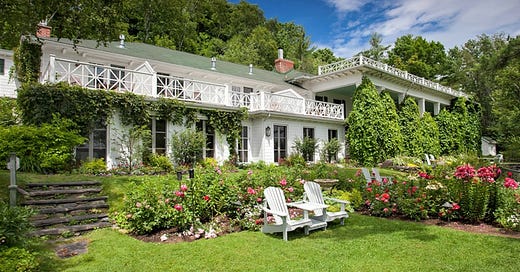Beyond the Village: Traveling with Inspector Gamache
My favorite Gamache adventures are the ones in which he goes traipsing about in other places
Hi friends!
We have a bonus essay this week from Melissa Joulwan, the co-creator of Strong Sense of Place, a website and podcast devoted to literary travel and books with vivid settings. She’s a long-time Inspector Gamache fan and we’re so excited to share this piece about how Louise Penny creates a sense of place outside our beloved Three Pines.
— Aya & Elizabeth
Like millions of readers around the world, I'm taken with Three Pines. Why wouldn't I be? It's got three Bs I love — bookstore, bistro, boulangerie — and is populated by people who are well worth knowing, even on their worst days. Its most magical quality may be that it's 'only ever found by people who are lost.' Who could resist such a place?
As Amy Tector explained in her essay, the village of Three Pines is based on the real-life Eastern Townships of Quebec. Spinning her word webs, Louise Penny has created an imaginary world so vivid we're transported to the town square at the foot of those three towering trees.
But I have a confession to make: My favorite Gamache adventures are the ones in which he goes traipsing about in other places, turning his eye on new landscapes, architecture, and climes. Penny's gift for description and detail creates a remarkably strong sense of place. Through Gamache, we enjoy the visitor's perspective — impressions of sights, sounds, smells, and tastes that might go unnoticed by a local accustomed to the wonder.
Thanks to the requirements of Gamache's job — that professional and personal need he has to poke at things until he understands them — we also get a peek at what's beneath the veneer of a location. Walking alongside Gamache, we experience the everyday of the place, the dark corners and dusky details that would likely be edited out of a travelogue.
Gamache — with his insightful quips, knowledge of history, and thoughtful nature — is excellent company over a glass of wine at the bistro, and a welcome travel partner out in the world, telling stories, navigating unfamiliar territory, and being his best sandalwood-and-charm self until the steely Patrón is required.
I also have to credit Penny for the skillful way she writes mysteries bound to their settings: The murder could only happen in that place at that time for those reasons. She also demonstrates an admirably cruel willingness to put Gamache in physical and emotional peril, all of which adds up to a very satisfying reading experience.
Let's take a trip with Gamache!
To a luxurious manor house on a lake...
A Rule Against Murder (Book #4)
(Photo courtesy of Manoir Hovey.)
In the first book that takes Gamache away from his beloved Three Pines, Penny also tackles two classic mystery tropes: a closed circle of suspects and a manor house murder.
The always-loving Gamache and Reine-Marie are celebrating their wedding anniversary at the Manoir Bellechasse, a remote, luxurious mansion on a lake surrounded by forest. Unfortunately, the Finney family — rich, cultured, horrible people — has also gathered at the inn for a family reunion. During a storm that disrupts the stifling heat of the summer, one of the Finneys is killed (in a most dramatic fashion). Gamache senses murder, and the suspect pool is filthy with prospects, including the family members who throw words like daggers, and the Bellechasse's staff: chef, maître d', and the imperious owner herself.
The Manoir Bellechasse is based on the real-life Manoir Hovey, a white clapboard inn on the shore of Lake Massawippi. Built in 1900, it was the summer home of industrialist Henry Atkinson. It boasted stables, a coach house, servants' quarters, and a private 9-hole golf course. Now it's a 5-star luxury getaway that offers a Bellechaisse Suite in honor of Penny's novel. (Watch Louise Penny talk about this book's setting and inspiration.)
Although the manor — both real and imaginary — is lovely to behold and comfortably appointed, it arose during a morally questionable period of Robber Barons when the haves were very clearly taking from the have-nots:
For there was something unnatural about the Manoir Bellechasse from the very beginning. It was staggeringly beautiful, the stripped logs golden and glowing. It was made of wood and wattle and sat right at the water's edge. It commanded Lac Massawippi, as the Robber Barons commanded everything. Over the years, the wilderness receded. The foxes and deer, the moose and bears, all the wild creatures hunted by the Robber Barons, crept away... Towns and villages sprang up. Cottagers, weekenders, discovered the nearby lakes. But the Bellechasse remained. It changed hands over the generations... As the fortunes of its creators waned, so went the lodge. It sat abandoned for many years, far too big for a single family and too remote for a hotel. Just as the forest was emboldened enough to reclaim its own, someone bought the place. A road was built, curtains were hung, spiders and beetles and owls were chased from the Bellechasse and paying guests invited in. The Manoir Bellechasse became one of the finest auberges in Quebec.
This conflict is reflected in the delightfully dastardly Finney family squabbles and the contrast between the Gamaches' love and the twisted attachments of the Finneys.
To the winter Carnaval in Quebec City...
Bury Your Dead (Book #6)
(Photo courtesy of Francis Gagnon, www.quebecregion.com)
The Carnaval de Québec (Quebec Winter Carnival) debuted in 1894. Since 1955, it's been an annual celebration of all things frosty in Québec City. Its patron saint is Bonhomme, a cheerful snowman that can make even the chilliest day seem brighter. The festivities include Bonhomme's Ice Palace, night-time parades on snow-covered streets, a frigid ice canoe race, and a masquerade ball in the grand ballroom of the historic hotel Château Frontenac.
Gamache is drawn to Québec City, not by the promise of fun in the snow, but to escape the sorrow and discord of the events of book #7, The Brutal Telling. He's on leave, nursing his wounds, losing himself in reading documents at the Quebec Literary and Historical Society.
I first read this book when it was published in 2010. When I re-read it recently, I was reminded of Penny's depiction of the Quebec Literary and Historical Society: the warming cups of tea, the hush of carpets underfoot, the centuries of grudges and histories in the books stacked on the shelves.
That coziness is shattered, of course, when a historian's body is found in the basement. Gamache is drawn into an investigation fraught with long-held tensions between the French and the English. It's a history lesson made personal and played out in stark contrast against the candy-colored frivolity of Carnaval.
In Penny's Québec City, snow squeaks, feet crunch, breath puffs against 'crisp, dark air,' bare branches knock together 'like the fingers of skeletons.' At Carnaval, 'fiddlers sawed away and kids skated and the fireworks lit the sky over the old city.'
Gamache's German shepherd Henri is firmly at his side throughout this story, gleefully chasing and chomping snowballs, curling up at Gamache's feet in the library, and joining his master on wintry walks. Although this novel is rich with vivid descriptions, it's this one that stays with me:
Gamache's feet were growing numb with cold as he stared at the Literary and Historical Society. Beside him Henri was lifting first one paw then another. The snow and ice were so cold it actually, and ironically, burned.
The image of Henri lightly prancing on the ice-covered ground to stay by his human is so poignant and so indicative of the experience of those who love Gamache. That kind of devotion can tear you up and put you back together at the same time.
To a cloistered monastery in the forest...
The Beautiful Mystery (Book #8)
(Photo courtesy of the Abbey of Saint-Benoît-du-Lac.)
For centuries, monasteries and abbeys — sacred spaces defined by their peaceful cloisters — have also been the sites of shocking violence. Religious wars, reformation, and greed have all taken their toll on houses of worship around the world.
A brutal murder at the (fictitious) 200-year-old monastery of Saint-Gilbert-Entre-les-Loups (St. Gilbert among the Wolves) draws Gamache and his right-hand man Beauvoir into the wilds of the Quebec forest. The setting is based on the real-life Abbey of Saint-Benoît-du-Lac, a Benedictine abbey overlooking Lake Memphremagog, founded in 1912.
The castle-like Saint-Gilbert's is tucked away even deeper in the wilderness than Three Pines. Reaching it requires a flight in a Cessna and an aluminum boat motored upriver through 'bracing spray' with 'the scent of fresh water and forest.' When Beauvoir sees the monastery for the first time, it's clear the two men are physically and spiritually very far from home:
At the very end of the bay a fortress stood, like a rock cut. Its steeple rose as though propelled from the earth, the result of some seismic event. Off to the sides were wings. Or arms. Open in benediction, or invitation. A harbor. A safe embrace in the wilderness. A deception. This was the near mythical monastery of Saint-Gilberte-Entre-les-Loupes. The home of two dozen cloistered, contemplative monks... It had taken hundreds of years for civilization to find them, but the silent monks had had the last word. Twenty-four men had stepped beyond the door. It had closed. And not another living soul had been admitted. Until today.
The monks within the cloistered walls have taken a vow of silence but are world-famous for their recordings of glorious Gregorian chants. Their home is a sanctuary of beauty and contemplation — until the choir director Frère Mathieu is found in the garden with his head bashed in.
Penny goes all-in on Gothic tropes and atmosphere to glorious effect. There's a missing medieval manuscript, secret chambers, crumbling monastery walls, malevolent monks, ethereal chanting, and an intimate look at the day-to-day lives of these silent, singing men.
The conflicts between light and dark, faith and doubt, brotherhood and competition are embodied in the murder investigation and echoed in Gamache's personal struggles. As always, Penny melds the exterior dangers with the emotional ones, forcing Gamache to confront the devastating secrets and conflicts in his own life while solving this brutal crime.
To the glittering city of Paris...
All the Devils are Here (Book #16)
(Photo courtesy of Nil Castellví/Unsplash.)
My husband Dave and I have a long tradition of saying, 'Paris is always a good idea.' We need to perhaps amend that to, 'Paris is always a good idea unless Louise Penny is telling your story.'
In this novel, the first time Gamache leaves Canada, he and Reine-Marie are in Paris with their extended family in anticipation of their granddaughter's birth. It's a celebratory time, although there's palpable tension between the Inspector and his son Daniel. After a family dinner at a neighborhood bistro, Gamache's godfather Stephen is struck by a hit-and-run driver, thus answering with a resounding 'no' the ongoing question: Can Gamache enjoy a vacation without some kind of tragedy? Although the bistro in the novel remains unnamed, I pretend it's this one, L'Ami Jean, a lovely spot to indulge in rice pudding with salted caramel.
Penny pulls off a nice hat trick, taking Gamache (and us) to iconic Parisian sites: the Eiffel Tower, the Paris Archives, the posh Hôtel Lutetia, patisserie shops, the gardens of the Musée Rodin — while making the beautiful city feel sinister. This is no travel guide. Instead, it explores the secrets found in the shadows of the City of Lights.
Although this is our first excursion to Paris with Gamache, it's not his first time there:
Armand and his godfather had returned to Paris every year. Exploring the city, discovering new haunts. Then ending the day eating ice cream at the Hôtel Lutetia... The waiters always made a fuss of the boy, even when he grew into a man.
And so we learn that Gamache has a history with this town. As he struggles to unravel the mystery surrounding Stephen's accident, he's forced to reckon with father-son relationships and the truths he holds about his own life.
One of the many great gifts of travel is that it introduces us to more of this world we inhabit. By taking us out of our usual context, it also helps us see ourselves and our home more clearly. For me, Gamache's adventures outside Three Pines illuminate his character and make his return home, where it's safe and known and warm, all the sweeter.
Melissa Joulwan is the co-creator of Strong Sense of Place, a website and podcast devoted to literary travel and books with vivid settings. In each episode of the show, she and her husband David get curious about one destination and discuss five great books that took them there on the page. They also produce the short-form podcast The Library of Lost Time featuring two new book releases and a fun book- or travel-related distraction. Mel is also the author of the best-selling Well Fed cookbook series and the memoir Rollergirl: Totally True Tales From the Track. Learn more about Strong Sense of Place and get your hands on the free (beautiful) SSoP Reading Atlas at www.strongsenseofplace.com.
Notes from Three Pines is a short-run newsletter run through Substack celebrating and exploring Louise Penny’s Inspector Gamache books. Love Gamache or Ruth’s duck Rosa? Reply to this email, leave a comment or email notesfromthreepines@substack.com.
If you’re reading this on Substack or were forwarded this email, and you’d like to subscribe, click the button below.
Disclosure: We are affiliates of Bookshop.org and will earn a commission if you click through and make a purchase.










Thanks for the links and images of these beautiful places, Melissa! I also have been extra fond of the books that take place outside of Three Pines. Penny is a wonder and developing that strong sense of place as you articulate so well.
Great piece, thank you, Mel! Book 8 was one of my very favorites & it definitely had so much to do with the setting... Totally agree that trips away from Three Pines make the return all that much sweeter!